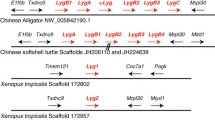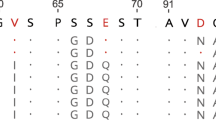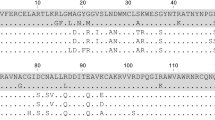Summary
Complete amino acid sequences are presented for lysozymesc from camel and goat stomachs and compared to sequences of other lysozymesc. Tree analysis suggests that the rate of amino acid replacement went up as soon as lysozyme was recruited for the stomach function in early ruminants. The two lysozymes from goat stomach are the products of a gene duplication that probably took place before the divergence of cow, goat, and deer about 25 million years ago. Partial sequences of three lysozymes from goat tears indicated that (a) the goat tear family of lysozymes may have diverged from the stomach lysozyme family by an ancient duplication and (b) later duplications are probably responsible for the multiple forms of tear and milk lysozymes in ruminants.
Similar content being viewed by others
References
Allensmith MR, Drell D, Anderson RP, Newman L (1971) Comparison of electrophoretic mobility of tear lysozyme in 50 subjects. Am J Ophthalmol 71:525–529
Alnemri ES (1985) Isolation and characterization of goat tear lysozyme. MSc thesis, University of Jordan, Amman
Cortopassi GA, Wilson AC (1989) Electrophoretic survey of mouse lysozymes with an improved way of detecting lysozyme activity in gels. In: Smith-Gill SJ, Sercarz EE (eds) The immune response to structurally defined proteins: the lysozyme model. Adenine Press, Schenectady NY, pp 87–96
Cortopassi GA, Wilson AC (1990) Recent origin of the plysozyme gene in mice. Nucleic Acids Res 18(7)(in press)
Dobson DE, Prager EM, Wilson AC (1984) Stomach lysozymes of ruminants. I. Distribution and catalytic properties. J Biol Chem 259:11607–11616
Duhaiman AS (1988) Purification of camel milk lysozyme and its lytic effect onEscherichia coli andMicrococcus lysodeikticus. Comp Biochem Physiol 91B:793–796
Godovac-Zimmermann J, Conti A, Napolitano L (1988) The primary structure of donkey (Equus asinus) lysozyme contains the Ca(II) binding site of α-lactalbumin. Biol Chem Hoppe-Seyler 369:1109–1115
Hammer MF, Schilling JW, Prager EM, Wilson AC (1987) Recruitment of lysozyme as a major enzyme in the mouse gut: duplication, divergence, and regulatory evolution. J Mol Evol 24:272–279
Irwin DM, Wilson AC (1989a) Multiple cDNA sequences and the evolution of bovine stomach lysozyme. J Biol Chem 264:11387–11393
Irwin DM, Wilson AC (1989b) Roles for gene amplification as well as regulatory and structural gene changes in the adaptive evolution of ruminant stomach lysozymes [abstr]. J Cell Biochem Suppl 13C:97
Irwin DM, Wilson AC (1990) Concerted evolution of ruminant stomach lysozymes: characterization of lysozyme cDNA clones from sheep and deer. J Biol Chem 265:4944–4952
Irwin DM, Sidow A, White RT, Wilson AC (1989) Multiple genes for ruminant lysozymes. In: Smith-Gill SJ, Sercarz EE (eds) The immune response to structurally defined proteins: the lysozyme model. Adenine Press, Schenectady NY, pp 73–85
Jollès P, Schoentgen F, Jollès J, Dobson DE, Prager EM, Wilson AC (1984) Stomach lysozymes of ruminants. II. Amino acid sequence of cow lysozyme 2 and immunological comparisons with other lysozymes. J Biol Chem 259:11617–11625
Jollès J, Jollès P, Bowman BH, Prager EM, Stewart C-B, Wilson AC (1989) Episodic evolution in the stomach lysozymes of ruminants. J Mol Evol 28:528–535
Laemmli UK (1970) Cleavage of structural proteins during the assembly of the head of bacteriophage T4. Nature 227:680–685
Lowry OH, Rosebrough NJ, Farr AL, Randall RJ (1951) Protein measurement with the Folin phenol reagent. J Biol Chem 193:265–275
Nitta K, Sugai S (1989) The evolution of lysozyme and α-lactalbumin. Eur J Biochem 182:111–118
Osserman EF, Canfield RE, Beychok S (eds) (1974) Lysozyme. Academic Press, New York
Padgett GA, Hirsch JG (1967) Lysozyme: its absence in tears and leukocytes of cattle. Aust J Exp Biol Med Sci 45:569–570
Prager EM, Wilson AC (1988) Ancient origin of lactalbumin from lysozyme: analysis of DNA and amino acid sequences. J Mol Evol 27:326–335
Prieur DJ (1986) Tissue specific deficiency of lysozyme in ruminants. Comp Biochem Physiol 85B:349–353
Savage DE, Russell DE (1983) Mammalian paleofaunas of the world. Addison-Wesley, Reading MA
Stewart C-B, Wilson AC (1987) Sequence convergence and functional adaptation of stomach lysozymes from foregut fermenters. Cold Spring Harbor Symp Quant Biol 52:891–899
Stewart C-B, Schilling JW, Wilson AC (1987) Adaptive evolution in the stomach lysozymes of foregut fermenters. Nature 330:401–404
White FH Jr, McKenzie HA, Shaw DC, Pearce RJ (1988) Studies on a partially purified bovine milk lysozyme. Biochem Int 16:521–528
Author information
Authors and Affiliations
Rights and permissions
About this article
Cite this article
Jollès, J., Prager, E.M., Alnemri, E.S. et al. Amino acid sequences of stomach and nonstomach lysozymes of ruminants. J Mol Evol 30, 370–382 (1990). https://doi.org/10.1007/BF02101891
Received:
Revised:
Accepted:
Issue Date:
DOI: https://doi.org/10.1007/BF02101891




